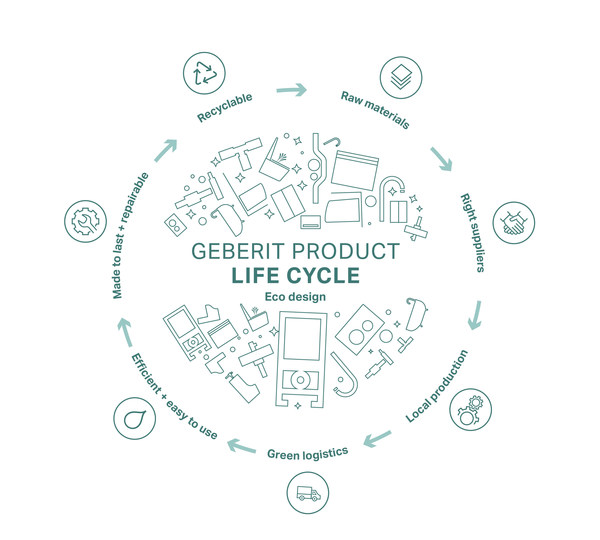[ad_1]
SINGAPORE, Aug. 22, 2022 /PRNewswire/ — Geberit, a market leader in bathroom systems and sanitary technology, is spearheading the charge for pure, sustainable products with its eco-design. By developing energy-efficient and reliable systems that are high quality and well-designed, Geberit creates added value with the lowest possible energy consumption — for customers, the environment, and society as a whole.

The eco-design principle analyses the entire life cycle of a product in ecological, economic and social terms – from the procurement of raw materials to disposal or recycling.
According to the latest UN Intergovernmental Panel on Climate Change (IPCC), Southeast Asia is one of the world’s most at-risk regions regarding climate change. It is now bearing the brunt of global e-waste. As concerns grow around the waste generation and management, Geberit is forging a more sustainable future with long-lasting, durable products that significantly reduce waste, protect the environment, and improve people’s lives across the region.
“In light of a worsening climate crisis with more natural disasters, we must all do our part to reduce waste in our building designs, particularly in Southeast Asia, where the effects of global warming are felt the most. For more than a decade and a half, Geberit has used our pioneering eco-design principle to create a sustainable quality of life for people worldwide. As demand for eco-design grows in 2022, we are ready to answer the call with high-quality, durable products constructed from sustainable materials, which reduce waste, and save water throughout their life cycle,” says Michael Allenspach, Product and Technical Director at Geberit.
Indeed iCon-ic: eco-design principles are applied across Geberit’s entire product portfolio
Since 2007, over 170 eco-design workshops have been held in product development. Geberit’s eco-design principle has since guided the company to design better products than their predecessors from an ecological perspective without sacrificing on quality, functionality, or durability. These principles can be seen in action across the Geberit range, such as in its iCon WC product range. Geberit’s wall-hung WCs feature a new flush guide made from 69% recycled ABS plastic. Meanwhile, the iCon Rimfree Plus technology and new flush valve type 212 with flush volumes of 4/2 litres use recycled plastics exceeding 50%. This can save roughly 1,000 tonnes of CO2 yearly. Meanwhile, the Sigma 12cm concealed cistern with Geberit’s flush valve 212 reduces water consumption. The flush is triggered via the recyclable Sigma30 actuator plate fastened in a frame made from 100% recycled ABS.
Incorporating the eco-design principle across the product life cycle
Geberit’s stringent eco-design criteria contribute to the circular economy and are applied to all stages of the product life cycle, from obtaining raw materials to disposal. In addition to selecting the most suitable materials, the continuous search for environmentally friendly, pollutant-free alternatives, and its intelligent resource-saving design, Geberit products significantly reduce waste with a durable design and service life that spans several decades.
With demand for eco-design continuing to rise, Geberit plans to continue using its sustainability criteria to create better products for people and the planet. For more information on Geberit’s sustainability initiatives, please visit https://www.geberit.com/company/sustainability/.
About Geberit
The globally operating Geberit Group is a European leader in the field of sanitary products. Geberit operates with a strong local presence in most European countries, providing unique added value when it comes to sanitary technology and bathroom ceramics. The production network encompasses 26 production facilities, of which 4 are located overseas. The Group is headquartered in Rapperswil-Jona, Switzerland. With around 12,000 employees in approximately 50 countries, Geberit generated net sales of CHF 3.5 billion in 2021. The Geberit shares are listed on the SIX Swiss Exchange and have been included in the SMI (Swiss Market Index) since 2012.
[ad_2]
Source link
